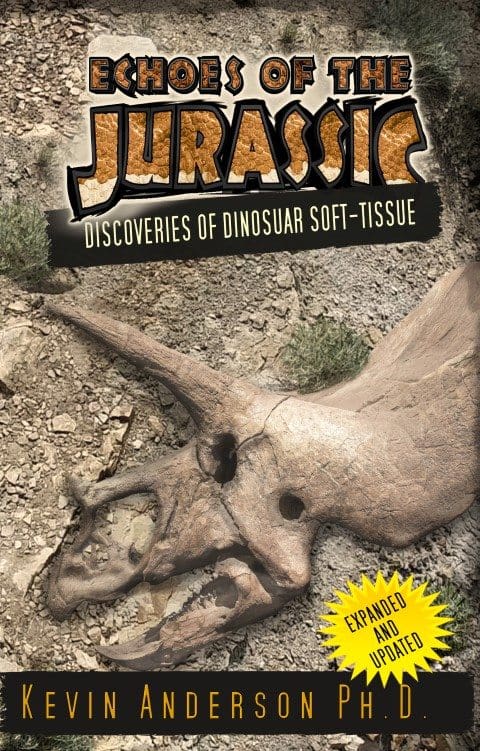Clickable Biomaterial Fossils Papers List
 Co-author of a Triceratops soft tissue paper, Kevin Anderson challenges Dr. Mary Schweitzer's claim that biological iron has the ability to preserve dinosaur biological material for tens of millions of years. On Real Science Radio, Bob Enyart and Dr. Anderson, a molecular biologist, describe Schweitzer's two-year experiment, which she then extrapolated to 68 million years, and they discuss the many physics and depositional factors that falsify the extraordinary claim of the famed paleontologist, whom RSR amiably refers to as the Iron Maiden. See the conclusion at rsr.org/ms2.
Co-author of a Triceratops soft tissue paper, Kevin Anderson challenges Dr. Mary Schweitzer's claim that biological iron has the ability to preserve dinosaur biological material for tens of millions of years. On Real Science Radio, Bob Enyart and Dr. Anderson, a molecular biologist, describe Schweitzer's two-year experiment, which she then extrapolated to 68 million years, and they discuss the many physics and depositional factors that falsify the extraordinary claim of the famed paleontologist, whom RSR amiably refers to as the Iron Maiden. See the conclusion at rsr.org/ms2.
* Challenges to and discussion of the iron preservation model:
- 2020 Microscopy Today published the Armitage and Solliday discovery of Triceratops blood clots, veins, valves, and nerve fibers, concluding "that free iron was unavailable... in these Triceratops bones..."
- 2019 More T. rex Soft Tissues at ICR by paleobiochemist PhD Brian Thomas, "Fenton chemistry preservation mechanism suffers big flaws. For one, Fenton reactions overwhelmingly break apart more biomolecules than they bind together. But the biggest flaw is the fact that so many researchers have found a flood of evidence for original proteins themselves, not only the more resistant chemicals that a fraction of Fenton reactions would produce. Thus, even if Fenton reactions produced resistant molecules, then so what? Results continually show the presence of original biochemicals..."
- 2016 A Biochemical Challenge to the Evolutionary Timescale at AIG by PhD Kevin Anderson
- 2015 Soft Tissue Time Paradox at ICR by PhD physicist Vernon Cupps
- 2015 Can Iron Preserve Fossil Proteins for Eons? at ICR by Brian Thomas
- 2015 Dinosaur Peptide Preservation and Degradation in CRSQ by DeMassa and Boudreaux (summarized by Wile)
- 2014 Dinosaur soft tissue at CMI by Calvin Smith, "evolutionists turn to iron to preserve the idea of millions of years."
- 2013 Dinosaur Soft Tissue Preserved by Blood? at ICR by Brian Thomas And in a post iron-age claim:
And in a post iron-age claim:
- 2019 Does the Toast Model Explain Fossil Protein Persistence? at ICR by paleobiochemist PhD Brian Thomas.
* Factors that Lead to Tissue Decomposition: The folowing list is based on a presentation given by an industry colleague of Dr. Anderson, ICR's Brian Thomas in August 2013 at a Pittsburgh creation conference. Bob Enyart was in attendance considering the apparent contradiction of extant biological tissue in 100-million year-old fossils and wondering how many different rescue devices evolutionists would eventually appeal to in addressing these many factors of degradation:

- Hydrolysis
- Chemotropism
- Microbes
- Friction
- Oxidation
- Autolysis
- Radioactive decay
- Temperature changes
- Molecular motion
Clickable Biomaterial Fossils Papers List
 * You may be interested in:
* You may be interested in:
- our shared Google spreadsheet linking to 100+ biomaterial fossil papers at bflist.rsr.org
- the great book by Dr. Kevin Anderson, Echoes of the Jurassic
- the presentation by Bob Enyart, embedded below, filmed in Malibu on the Pepperdine campus titled, There ARE No Secular Theories of Origins. God Exists, They Don't.
- baseball player and BEL interviewee David Bote, drafted by the Cubs, makes his first MLB debut vs. the Rockies. Update: Congratulations David for hitting a double in your first Major League at-bat!
* Areas of Interest for Research: (This list can be accessed directly at rsr.org/biomaterial-fossils-additional-research.)
- See our "Candidate" papers list at about Row 190 at bflist.rsr.org.
- Biomaterial in amber, in a handful of the 110+ papers at bflist.rsr.org, needs more investigation.
- Clam shells, made 1% of protein, are often not permineralized, such as the allegedly 85Mya specimens that "retain some original shell" as in Pueblo County, Colorado from the Smoky Hill Shale Member of the Niobrara Formation.
